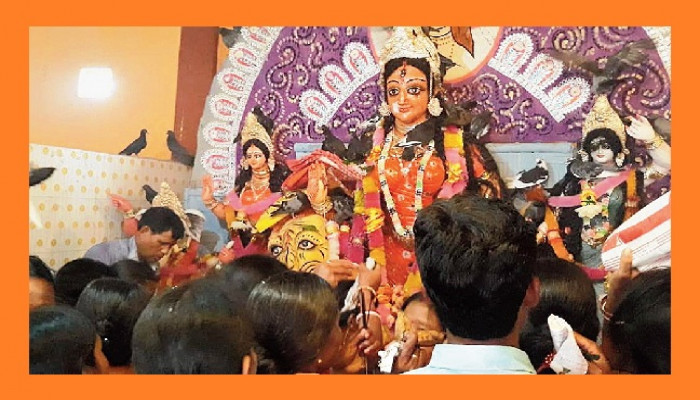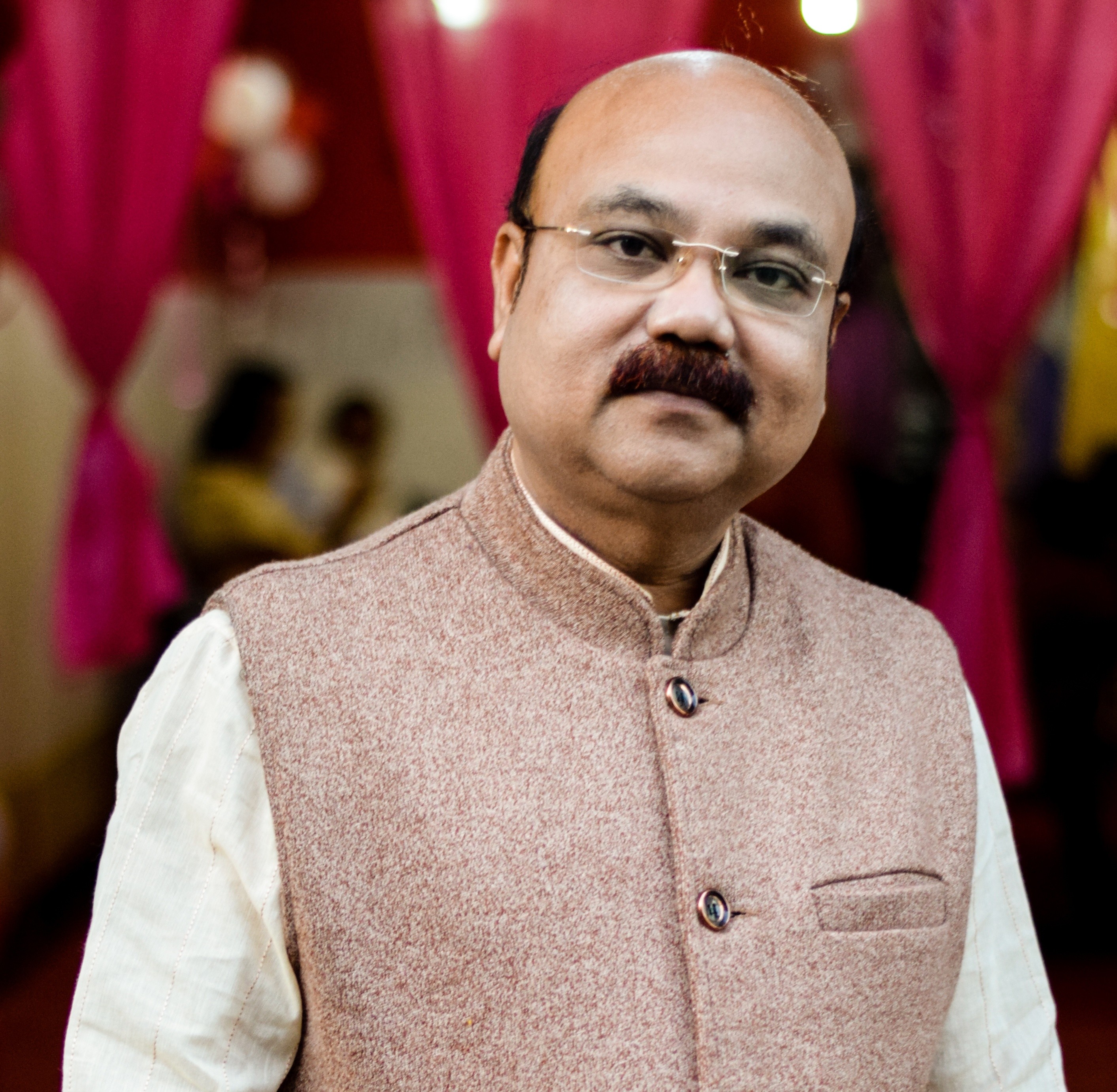From Farewell to Renewal: The Immersion of Durga and the Resurrection of Bhandani
- In Religion
- 05:52 PM, Oct 04, 2025
- Bidhayak Das Purkayastha
When the joyous resonance of “Durga Ma Ki Jai” fades into silence and the goddess is immersed in the sacred rivers on ‘Dashami’, an aching emptiness descends across the hearts of Bengalis. For most, Durga Puja culminates in this bittersweet moment – the celebration of victory dissolving into the sorrow of farewell. Yet, in the heartlands of North Bengal – in Jalpaiguri, Alipurduar, Cooch Behar and Dooars – this grief does not linger. Instead, a remarkable tradition unfolds. On ‘Ekadashi’, just one day after Dashami, a new goddess emerges – “Devi Bhandani”, the blessed mother of the Rajbongshi community. For them, farewell is not the end, but the beginning of renewal.
Bhandani: The Village Goddess of Simplicity
Unlike the familiar Durga of Bengal’s grand autumnal festival, Bhandani is not the ‘Mahishasurmardini’, the ten-armed slayer of demons. Instead, she is depicted as an ordinary woman with two hands, tender and approachable, yet carrying divine grace. Her mount is not on the lion but the ‘tiger’, a reflection of the once-prevalent Royal Bengal tigers of Baikanthapur forest.
Lakshmi, Saraswati, Kartikeya and Ganesha accompany Bhandani. But her iconography omits the violent imagery of demon-slaying. Here, she is not the warrior goddess but the nurturing guardian of crops, forests and households. As an elder of the Rajbongshi community once explained in an oral account:
"Bhandani Maa is not the goddess of war. She is the goddess of our fields, our granaries and our homes. She is the daughter who always comes back."
The Legend: When Durga Lost Her Way
The most popular legend narrates that after her immersion on Dashami, Durga, while returning to Kailash, lost her way in the dense forests of North Bengal. In the dark of night, villagers heard the sound of a young bride weeping. Out of compassion, they sheltered her. The next morning, before departing, she revealed her true identity.
Deeply moved by their kindness, she blessed them:
“Your harvests will be abundant, your granaries never empty, for you gave shelter to me when I was lost.”
This story, retold for generations, anchors Bhandani as both goddess and guest – forever tied to the soil and spirit of the Rajbongshi community.
Historical Roots: A Festival of Innovation and Identity
Scholars trace the Bhandani Puja back nearly five centuries. In medieval Bengal, Durga Puja could only be organised with the sanction and financial support of local kings or zamindars. The Rajbongshi peasants, unable to bear such costs, innovated their own ritual: Bhandani Puja – a festival humbler in form but equally divine in spirit.
As folklorist Sailen Debnath observes in his studies on North Bengal:
“Bhandani Puja is a unique blend of necessity and creativity. It allowed the Rajbongshis to remain connected to Durga while crafting a goddess in their own image – rooted in their ecology, economy and community.”
Thus, Bhandani was not just a substitute for Durga, but an assertion of cultural autonomy and ethnic identity.
Rituals and Festivities: From Ekadashi to Lakshmi Puja
The celebration begins on Ekadashi, a day after Dashami, with Jatra Puja – a ritual invoking prosperity for crops and cultivation. The festivities continue for four days, extending in some places up to Lakshmi Puja. Villages such as Mainaguri, Dhupguri, Malbazar, Meteli, Barnish Gram and Shalkumarhat and parts of Dooars transform into festive grounds.
The highlight is the fairs (melas) that last throughout the night. Stalls brim with handicrafts, local delicacies and folk games; jatra troupes perform plays under makeshift bamboo stages; farmers, artisans and tea garden workers gather in joyous celebration. The Baghrabahani Bhandani Puja is particularly renowned, its rituals steeped in Tantric traditions that lend the festival an aura of mystery.
For the agrarian Rajbongshi community, Bhandani Puja is more than worship – it is a festival of livelihood and economy, weaving together faith, markets and rural entertainment.
Socio-Cultural Significance: Beyond the Rajbongshis
While originally rooted in the Rajbongshi community, the festival today draws participation from a mosaic of groups – tribal communities, tea plantation workers and neighbouring Bengali Hindus. It has become a multi-ethnic rural carnival, reflecting the plural spirit of North Bengal.
Anthropologist Dipak K. Roy describes this beautifully- “Bhandani Puja reveals how faith negotiates with geography. Where forests dominate and farming sustains life, the goddess must embody both ecology and fertility. Bhandani is precisely that – she is the sacred daughter of the soil.”
Thus, the festival embodies not just religion, but ethnic resilience, ecological consciousness and community solidarity.
From Dashami’s Tears to Ekadashi’s Renewal
The emotional power of Bhandani Puja lies in its timing. When the rest of Bengal grieves at the departure of Maa Durga, North Bengal finds hope and joy in renewal. Dashami’s sorrow dissolves into Ekadashi’s celebrations. The rhythm of mourning and renewal reflects a deeper truth about rural life: grief is transient, but the cycles of faith and harvest always continue.
In rustic folk songs sung during the fairs, one often hears verses like:
“Dashami took her away, but Ekadashi brings her back,
O Bhandani Maa, fill our homes, guard our fields,
Never let our granaries lack.”
The Eternal Guest of The Villages
Bhandani Puja is not a mere extension of Durga Puja. It is a living chronicle of folklore, faith and survival. It tells the story of how villagers once sheltered a lost goddess and, in return, she became their eternal guest – blessing their fields and homes with abundance.
The myth of Bhandani is precisely such a truth – an enduring cultural memory where the goddess is not distant, but intimate; not a slayer of demons, but a mother of soil and harvest.
Thus, every year in the villages of North Bengal, when Durga Puja bids farewell on Dashami, Bhandani rises on Ekadashi, reminding her devotees that endings are never final, and that renewal always follows farewell.
Disclaimer: The opinions expressed within this article are the personal opinions of the author. MyIndMakers is not responsible for the accuracy, completeness, suitability, or validity of any information on this article. All information is provided on an as-is basis. The information, facts or opinions appearing in the article do not reflect the views of MyindMakers and it does not assume any responsibility or liability for the same.







Comments